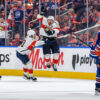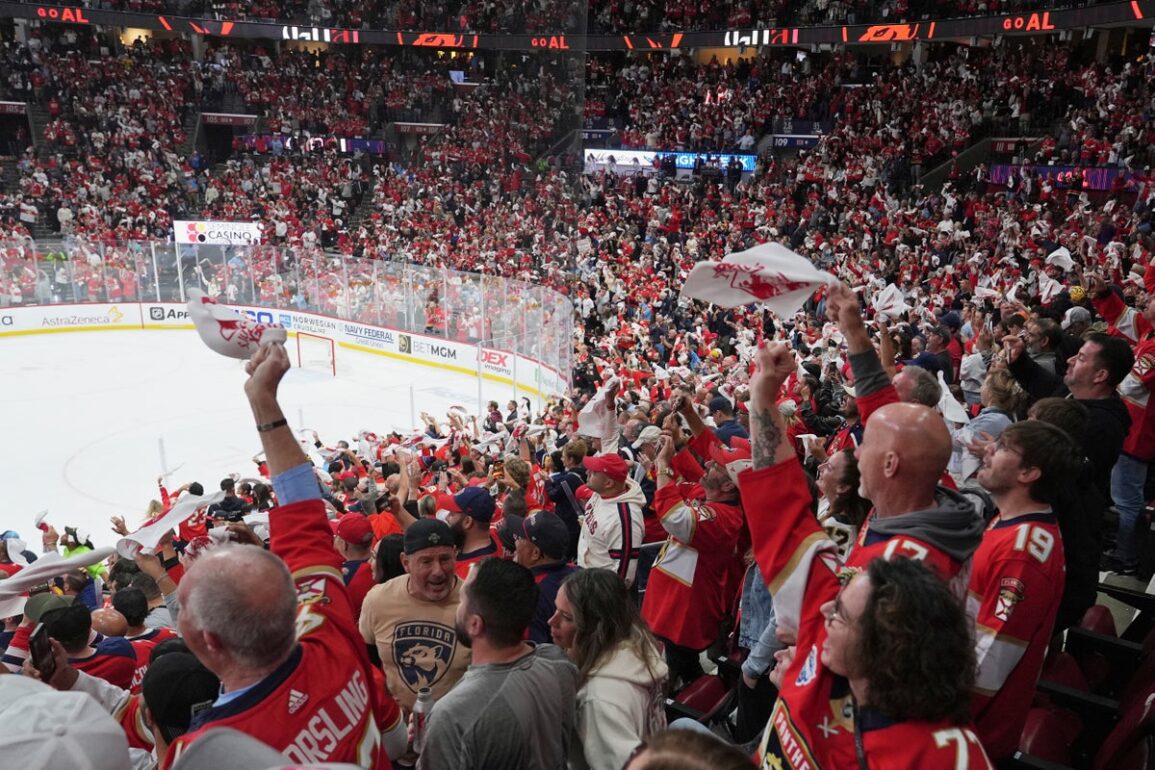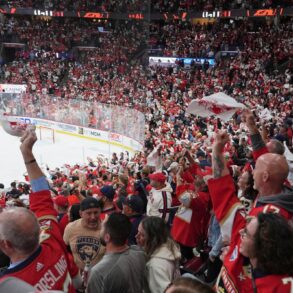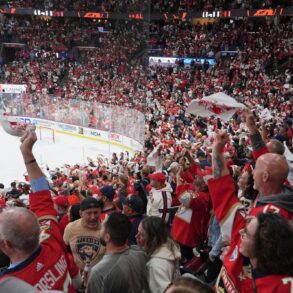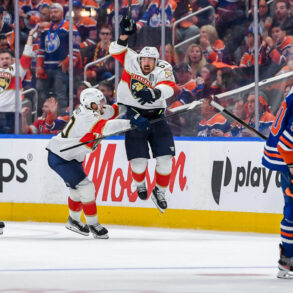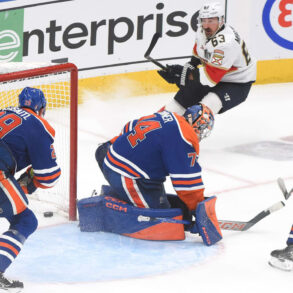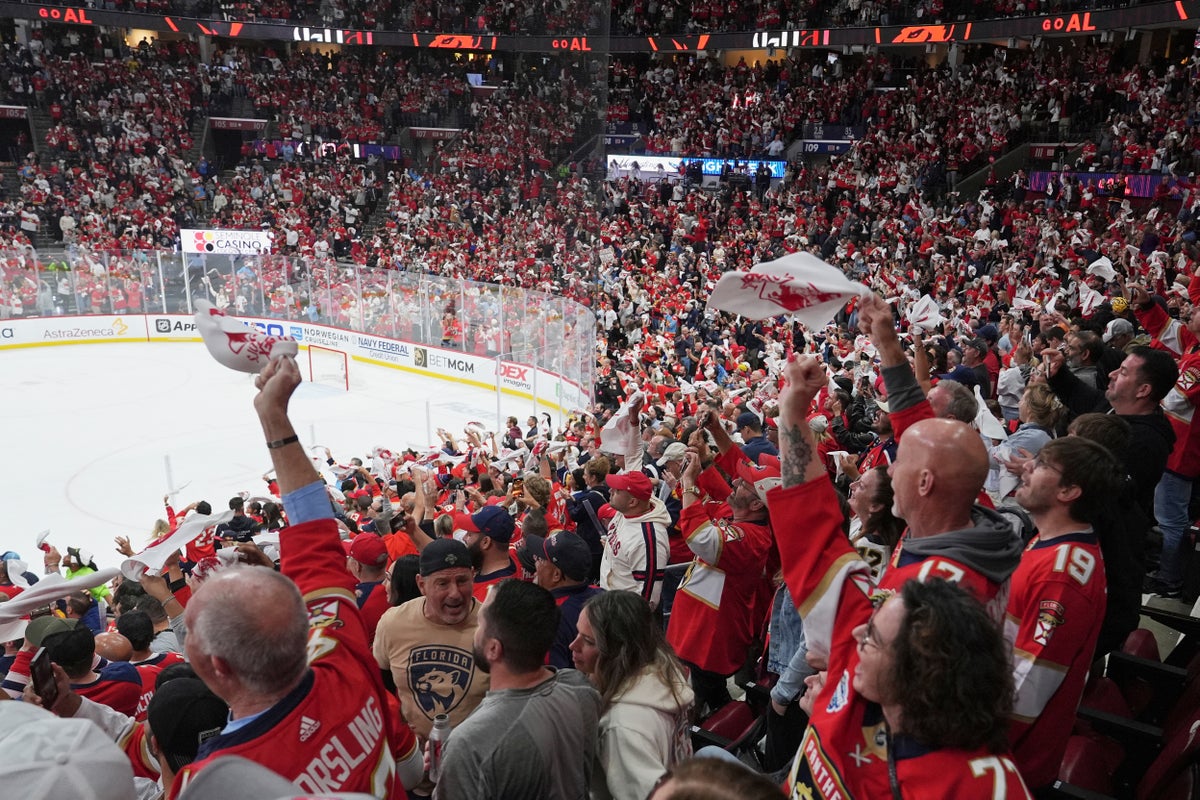
Popeye Jones was an NBA rookie with the Mavericks the same season that Dallas debuted its new NHL team, and he decided to go to a Stars game after meeting future Hall of Fame player Mike Modano.
“I couldn’t figure out hockey. They were jumping over and off the ice … I’m like, ‘what’s going on with this sport?'” Jones said. “The puck flew up, I remember it hit somebody in the nose, blood was all over the ice and they kept playing.”
Back during that 1993-94 season, before he became a hockey dad, the 6-foot-8 Tennessee native who had grown up playing basketball, football and baseball was like many people in the South: He knew nothing about hockey even as the NHL was making a push into non-traditional markets.
Those days are long gone. NHL teams in the South are playing for and winning the Stanley Cup in packed arenas and there is steady growth when it comes to youth participation. Football may still be king in many Sun Belt locales, but hockey has been welcomed from Las Vegas to Texas to Nashville to North Carolina — and certainly in Florida.
Jones has two sons who are now NHL players. Seth Jones, a defenseman for the Florida Panthers, is playing in the Stanley Cup Final after the 12-season veteran, the fourth overall pick by Nashville in the 2013 draft, was traded from Chicago to the defending champions in March. Caleb Jones played for the Los Angeles Kings, his fourth team the past seven years.
The expansion Panthers came into the league with Anaheim in 1993-94, at the same time the Minnesota North Stars moved to Dallas. The Tampa Bay Lightning and Ottawa Senators were expansion teams the previous season, and the Hartford Whalers moved to Carolina and became the Hurricanes in 1997.
Shane Willis remembers playing with the Hurricanes following the NHL’s arrival in North Carolina — a process featuring a two-year transition to Greensboro before moving to Raleigh — and sometimes noticing a sparse home crowd during warmups.
“I’m like, ‘Is anybody coming?’” said Willis, now Carolina’s manager of youth and amateur hockey after five seasons as an NHL player.
That isn’t the case now, with Carolina having won a Stanley Cup in 2006 and currently on a seven-year run of winning at least one postseason series, including this year’s run to the East final.
Southern success
This is the sixth season in a row a team from Florida has reached the Stanley Cup Final. The Panthers are there for the third year in a row, this time in a rematch against Edmonton. Tampa Bay also made it to the final three straight seasons, winning the Cup the first two.
The Lightning’s run began by beating Dallas in 2020 in what is still the the “southernmost” Stanley Cup Final — except that entire postseason was played in Canada after the regular season was shortened because of the pandemic.
Dallas made its third West final in a row this year, coming up short of another Cup chance. But they were the first Sun Belt team to hoist the Stanley Cup in 1999, followed by Tampa Bay in 2004.
Every game in the conference finals in 2023 was played in the Sun Belt, a first. The Panthers beat Carolina in the East like they did this year, and Dallas lost to Vegas in the West.
Popeye, Mo and Sakic
Popeye Jones met Modano after getting invited to do an appearance during a Dallas Cowboys game.
“Not being a hockey fan, I really didn’t know who he was and he didn’t who I was. But we just struck up a conversation and started talking,” Jones said. “Just general talk about sports and whatever, and he was such a nice guy and I enjoyed sitting there and talking to him.”
That helped Jones become a Stars fan. They both played home games at the since-demolished Reunion Arena before Jones was traded to Toronto and later Boston, homes of two of the NHL’s Original Six teams. His only season playing in Denver was 1999-2000, when the Avalanche lost to the Stars in consecutive West finals before winning the Cup in 2001. It was there that he got to know Avs star Joe Sakic, another future Hall of Fame hockey player and now the team’s president of hockey operations.
Jones’ oldest son, Justin, came home from school one day in the Denver area and said he wanted to play hockey, which had a significant influence on Seth, who was 5 or 6 at the time. With his sons interested in playing an unfamiliar sport , Jones sought advice from Sakic, who said the boys needed to take skating lessons.
Seth Jones started playing hockey in Colorado, but was born in Texas and was on some Stars-affiliated youth teams after his dad later returned to the Mavericks.
“When I was there, you could see more and more kids starting to play in Texas,” the 30-year-old Panthers defenseman said. “And then really the past eight to 10 years, you see kids actually moving from the northern cities down to Texas because the hockey has really grown. Where before, all the good kids out of the southern cities would move up north to Chicago and Michigan and New York and these places.”
More and more players
The number of players registered with USA Hockey has grown significantly in Southern states over the past 20 seasons.
USA Hockey said 4,793 players registered in North Carolina for the 2005-06 season, with roughly 2,400 of those being 18 or younger. That overall number of players jumped 19.5% (to 5,728) for the season following their 2006 Cup run.
By the 2024-25 season, the state had 8,698 players (up 81.5% from 2005-06) with 5,608 being 18 or younger (up 135.5%), though Willis noted the actual number is likely higher since not all players register with USA Hockey.
The total number of registrations have increased even more in Florida and Texas over the past two decades.
In Florida, the total number of players has gone from 9,363 in 2005-06 to 22,888 (a 144.5% increase), with the number in the 18 or younger age groups nearly doubling to 10,277. Texas went from 7,017 to 17,346 total registrations (147.2%) in that same span, with those 18 and under going from 5,457 to 7,199 (31.9%).
Pete DeBoer, the Stars coach the past three seasons, had his first NHL head coaching job with Florida from 2008-11. He recalls the Lightning and Panthers then playing before sparse crowds with questions about whether those teams would even stay in those markets.
“To see where they’re at now is really impressive,” DeBoer said before the team fired him this past week. “Dallas for me is a perfect example of coming into a place and, you know, getting a foothold at the grassroots level, and that the amount of rinks, ice surfaces and facilities and kids playing minor hockey here in Dallas is way bigger than I ever anticipated.”
Much of that came as a result of the 1999 Stanley Cup for the Stars.
“They won, they captured the city’s attention and all this stuff got done. Rinks got built,” DeBoer said. “I think Florida didn’t get that done early, but is doing it now and they’re going to reap the benefits of that. I think when you get a team that wins and it’s in a non-traditional market, I think the benefits roll out for decades.”
Introducing the game
For the Hurricanes, early outreach included going to area schools and essentially running PE classes as an introduction to the sport. The team, aided by grant money from the NHL, has more recently purchased equipment such as balls, sticks and Hurricanes-logo apparel to donate to more than 100 schools. The team this year partnered with Raleigh suburb Apex to open two public street hockey rinks.
Carolina, Dallas and Florida all have tie-ins to to the “Learn to Play” umbrella program created by the NHL and NHL Players’ Association to introduce boys and girls, and even adults, to the sport. Those programs include variations of providing hockey equipment and instruction, and on-ice workouts at multiple rinks in their areas.
“What you have to do is not only introduce the game of hockey to people, you have to introduce your brand. You have to make both things very attractive to parents to want to get involved,” Willis said. “I see so many parents now, they come to games and we talk about it: if you can create a hockey player, whether it’s street hockey or ice hockey, you’re creating three fans. Because that kid is going to come to a game with Dad, Dad and Mom, maybe a sibling. So then you’re in the range of three to four fans you’re creating.”
Popeye Jones knows how that can go, recalling a time when Seth Jones was 11 or 12 and the family wanted him to find something else to do in the summertime.
“A kid called and said hey they had some ice, you want to come and, you know, play some pickup hockey. At first I didn’t want him to, but I saw he was moping around the house,” the elder Jones said. “I told him to get his stuff. I’ll never forget it, he got this bag together so fast and got in that car and I was driving him to the rink and I looked at him and I saw this big grin and I said, ‘Well, I guess I got a hockey player.’”
___
AP Sports Writers Aaron Beard, Pat Graham and Tim Reynolds contributed to this report.
___
AP NHL playoffs: https://apnews.com/hub/stanley-cup and https://apnews.com/hub/nhl
This post was originally published on this site be sure to check out more of their content.




